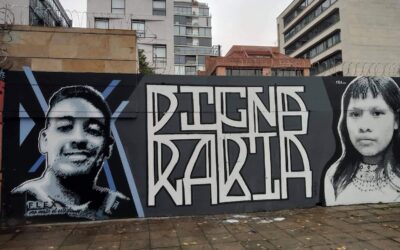Introduction
A contemporary pressing issue in both academic and practitioner circles in development, security and peacebuilding is the relationship between gender and conflict, a relation that cuts across themes, disciplines, and actors. As such, the study of the junctures between gender, conflict and peace have connected practitioners, policymakers, and academia in dealing with a range of critical practical questions on how conflict impacts differently men and women, how peacebuilding can be more inclusive and participatory through gender sensitivity practices (where gender differences and their role in producing social norms and dynamics inform different approaches towards sustainable peace), more critical issues surrounding the structural exclusion of women from peace and development programming, and the denunciation of peace practices as patriarchal and neoliberal in nature. In this sense, gender becomes a crossroads of war and peace.
In this sense, the issue of gender can bring together various critical and problem-solving issues regarding inclusion, participation and differentiation when discussing how the social construction of masculinities and femininities affect the prospects for dealing with violence, its aftermath, and for sustainable peace in post conflict scenarios. This text seeks to highlight different ways how gender is used as a lens to understand conflict, as an indicator towards inclusive and sustainable peacebuilding as well as a critical tool that helps identify contradictions and obstacles to victims and survivors. It will begin by looking at the crossroads between gender and conflict, providing some definitions, connections with trauma-healing and psychosocial discussions and tying them all with insights from transitional justice debates. Once this critical juncture is presented, the discussions move towards a problem-solving reflection on what can be done with gender within development, peacebuilding and human rights practice. By presenting ideas about gender mainstreaming and gender sensitivity, the discussion will bring attention to international frameworks for gender inclusion and proposals within the psychosocial and transitional justice fields that not only bring practical possibilities but also critical questions about the type of engagement with gender concerns in different practitioner fields.
Gender and conflict at a crossroad: the intersections between definitions, areas of study and critical possibilities
Within the context of violent conflict, gender emerges as a relational concept, dedicated to observing “the socially constructed roles and relationships, personality traits, attitudes, behaviors, values, relative power and influence that society ascribes to the two sexes on a differential basis”[1]. It requires an understanding of power relations between genders and how these gendered power relations relate to existing conflicts[2]. Due to its emphasis on relations, it explores processes of negotiation, bargaining and exchange between men and women in different contexts and is concerned with how the construction of masculinities and femininities determines access to power and resources in a society[3].
Contributors from the fields of psychology and sociology to the study of conflict also highlight the importance of connections between trauma, mental health, and gender. Seguin[4] discusses different forms of trauma and trauma-coping strategies through including a gendered analysis of conflict:
a.) how forced displacement and loss of property often has multilevel impacts on other resources for women, particularly livelihood, social networks and physical and mental health,
b.) Poverty derived from wartime circumstances is recognized as a source of constant stress for many women who were forcibly transformed into the only household breadwinners,
c.) women´s adoption and expansion of new roles and responsibilities such as seeking employment, working, budgeting and
d.) positive cognitive restructuring expressed in an empowerment derived from meeting the challenges emerging from conflict, being more future-focused and developing different forms of agency (political, social, economic, cultural).
Gender matters as a marker for conflict-affected and fragile states in a variety of ways: gender equality is recognized normatively as a condition for achieving human rights, instrumental for conflict prevention, transformation, peacebuilding and in development work. According to U.N. Security Council Resolution 1325 a gender perspective requires addressing the specific needs of women, supporting local women´s peace initiatives and ensuring protection of women´s rights, beyond simply guaranteeing the presence of women during peace negotiations[5]. Such frameworks do not go uncriticized, as the emergence of resolutions like the 1325 and the laws and actional plans that derive from them have been criticized for constantly depicting women as victims and males as perpetrators, undermining the agency of women, failing to reflect on the variety of their experience and roles in armed conflict[6]. This framing of women as victims has led to an over-emphasis on protection, often overshadowing areas such as participation, prevention, and peacebuilding[7].
Within transitional justice (studying different mechanisms dealing with atrocities and violent legacies of armed conflicts) contributions have been made by focusing on the relation between conflict and gender: the recognition of how women have been excluded from contributing in social reconstruction activities during post-conflict work, the need to discuss reparations through analyzing the specific forms of victimization of women to understand needs for redress, the recognition of violence as a social practice embedded in masculinity and a constant preoccupation with the way patriarchal and neoliberal structures of governance can perpetuate tensions and conflict[8]. Fischer[9] writes how gender is a connecting point between transitional justice and peacebuilding via the recognition of gender-specific war crimes, promoting the need for practitioners to better understanding of gender, culture and power structures that informs their work. Haider[10] presents different gender themes from an evolving transitional justice practice: the recognition of systematic violence against women as a crime against humanity in criminal tribunal sin the mid-90s, the extension of discussions within the creation of the International Criminal Court about what accounts for sexual and gender based violence (from rape, enforced pregnancy, sterilization and the connected mental health affections), the underlying message from reparative practitioners of the need to understand multiple harms experienced by women, as a means to address patriarchy and gender inequalities.
Gender, development and peacebuilding: prospects for a problem-solving framework
The use of gender as a marker in conflict analysis and as a concept bringing different disciplines together towards the identification of structural causes of violence, is also utilized in the establishment of proposals of peacebuilding and development practice. Two key practices are worth highlighting when describing frameworks for gender inclusion: the first is gender mainstreaming, the assessment of the implications for women and men in any planned action in development and peacebuilding work, focused on how their concerns and experiences are considered in the design, implementation, monitoring, and evaluation of activities[11]. The other concept is gender sensitivity, the acknowledgement of gender differences and how they produce power relations and social norms, as an initial discussion before adopting approaches to conflict and development[12].
Such practices have allowed to bring together different practices that insist on taking gender seriously when it comes to engaging in development, security, and peacebuilding tasks. They demand gender analysis, systematically analyzing data on gender differences that permits identifying gender inequalities. They also contribute to defining gender empowerment activities, bottom-up processes for transforming gender-based power relations and awareness of the subordination of women and their capacities to change such structures. All of which are complemented by women rights activism, social movements that recognize the existence of legal prerogatives for women, denouncing the unfair experiences derived from their gender.
The role of international policy frameworks in this regard is noticeable, as both United Nations Security Council Resolutions 1325 and 1820 have established proposals for this type of women empowerment and protection amidst contexts of violence and insecurity. As a problem-solving proposal, UNSC 1325 moves forward by developing complex recognitions of underlying issues regarding the social constructions of femininity and masculinity: support for LGBTQ communities affected by violence, work surrounding the needs of women with disabilities and widowed by conflict, the intersectional dynamics of ethnicity, race and gender in armed conflict, among others[13]. Such agenda establishes a framework that operationalizes different processes: prospects for women´s leadership, gendered conflict analysis and mainstreaming, and ideas on how peace operations can incorporate gender into different activities, bringing together activities for prevention, participation, protection, relief and recovery[14]. It is noteworthy how such frameworks have permitted the inclusion of gender into the post 2015 development agenda, helping usher in goal 5 (achieving gender equality and empowerment of all women and girls) and goal 16 (promote peaceful and inclusive societies for sustainable development) into the Sustainable Development Goals.
The recognition of these varied frameworks and their application as development and peacebuilding work also comes with its drawbacks and critical considerations. Moran[15] recognizes how women´s leadership and empowerment are not natural traits but rather derived from traumatic experiences, hence require deployment and mobilization of material and symbolic resources that require constant multilayered support from all external, domestic, and local actors (reminding us that women´s antiwar efforts come as responses to the devastating impact of wars in civilians). Moran also highlights a paradoxical dilemma for women in conflict contexts where extreme violence has opened opportunities for progressive, egalitarian gender relations in places previously known for strong patriarchal structures (referring to experiences in Rwanda and Uganda particularly), leading to a recognition that the postwar moment is an opportunity for a (positive) radical reconstruction of gender. Such possibilities come with the underlying recommendation of supporting gender efforts and women in particular to avoid manipulation and further revictimization of their experiences within the contexts of peacebuilding and development
Other examples of these possibilities and critical warnings also appear within transitional justice literature. Buckley-Zistel and Zolkos[16] view a duality in the inclusion of gender within transitional mechanisms, on one hand the establishment of gender analysis in creating mechanisms for dealing with violence can help create new, improved social positions for women and different identities in a newly emerging post-conflict society. On the other it can reduce women to targets of sexual crime, constructing them as perpetual victims. Gendered transitional justice work can help also break the silence surrounding abuses perpetuated publicly by combatants against women but can hide the more private (domestic) forms of violence that occur both before and during violent conflict. This is particularly troublesome for proposals surrounding restitution and reparations, as a return to the roles prior to conflict may not be the desirable outcome for many within a war-affected society.
Conclusion: gender as a cross-disciplinary, critical and problem-solving concept
Through such different areas of analysis, it is easy to perceive gender as a cross-disciplinary lens that allows for the recognition of different complexities, possibilities, and critical dilemmas. Gender discusses power relations and by focusing on differentiated impacts between men and women, it uncovers obstacles to accessing power, decision-making and resources derived from the social construction of masculinities and femininities. Contributions from psychology help identify trauma, and trauma-healing as themes that cut across dilemmas of poverty, enforced transformation of women through conflict and prospects for empowerment and moving from victimization to survival as experienced by women in many conflict contexts. It is a theme that does not go unchallenged, as concerns about the perpetual portrayal of women as victims of conflict, the barriers to recognizing their agency as survivors, as participants in postwar politics and peacebuilding can demonstrate.
As a problem-solving arena, gender has the capacity to connect different frameworks that bring together development, peacebuilding, and human rights efforts. Practices such as gender mainstreaming and gender sensitivity show how much have debates on inclusion, participation, prevention, and peacebuilding have incorporated the needs and concerns of women and the evolution of gender as a defining concept. The establishment of international frameworks such as the UNSCR 1325 have permitted new efforts, architecture, and modes of understanding how to work with gender in security, peacebuilding and development activities. The same can be said about discussions of transitional justice, that move from the recognition of sexual and gender-based violence towards more holistic and transformative proposals that demand better reparative and reconciliatory frameworks where gender can contribute to expanding mechanisms and initiatives for dealing with wartime human rights abuses.
BIBLIOGRAPHY
W. Avis, Incorporating Gender Perspectives in Peace Operations since 2018, GSDRC, Birmingham 2021, link: https://gsdrc.org/wp-content/uploads/2022/01/1068_Gender_Perspectives_in_Peace_Operations.pdf.
A. Barrow, UN Security Resolutions 1325 and 1820: Constructing gender in armed conflict and international humanitarian law, in “International Review of the Red Cross”, XCII, 877.
S. Buckley-Zistel and M. Zolkos, Introduction: Gender in Transitional Justice, in “Gender in Transitional Justice”, Palgrave, 2012, link: https://papers.ssrn.com/sol3/papers.cfm?abstract_id=2267777.
J. Cóbar, E. Bjertén-Günter and Y. Jung, Assessing gender perspectives in peace processes with application to the cases of Colombia and Mindana, SIPRI, 2018, link: https://www.sipri.org/publications/2018/sipri-insights-peace-and-security/assessing-gender-perspectives-peace-processes-application-cases-colombia-and-mindanao.
M. Fischer, Transitional Justice and Reconciliation: Theory and Practice, in B. Austin e J. Giessmann, Advancing Conflict Transformation: The Berghof Handbook II, Barbara Budrich Publishers, New York 2011, pp. 406-430.
H. Heider, Transitional justice: Topic guide, GSDRC, Birmingham 2016, link: http://www.gsdrc.org/wp-content/uploads/2016/08/TransitionalJustice_GSDRC.pdf.
IPI, Incorporating Gender into UN Senior Leadership Training, New York 2019, link: https://www.ipinst.org/wp-content/uploads/2019/04/1903_Incorporating-Gender.pdf.
J. Johnston-Coeterier, A gender sensitivity resource pack, Institute of Human Rights Communication Nepal, 2014.
M. Moran, Gender, Militarism, and Peace-Building: Projects of the Postconflict Moment, in “Annual Review of Anthropology”, XXXIX, pp. 261-274.
S. Seguin, Aspects of loss and coping among internally displaced populations: Towards a psychosocial approach, in E. Fiddian-Qasmiyeh, Refuge in a Moving World: Tracing refugee and migrant journeys across disciplines, UCL Press, Londra 2020, pp. 289-305.
A. L. Strachan and H. Haider, Gender and conflict: Topic guide, GSDRC, Birmingham 2015, link: https://gsdrc.org/wp-content/uploads/2015/07/gender_conflict.pdf.
J. True, Women, peace and security in post-conflict and peacebuilding contexts (Policy Brief), NOREF, 2013, link: http://peacewomen.org/system/files/global_study_submissions/Jacqui%20True_NOREF%20policy%20brief.pdf.
UN Women, Gender mainstreaming in development programming – guidance note, 2014, link: https://unsdg.un.org/sites/default/files/gender-mainstreaming-issuesbrief-en-pdf.pdf.
Notes
[1] UN Women, Gender mainstreaming in development programming – guidance note, 2014, p. 42, link: https://unsdg.un.org/sites/default/files/gender-mainstreaming-issuesbrief-en-pdf.pdf.
[2] J. Cóbar, E. Bjertén-Günter and Y. Jung, Assessing gender perspectives in peace processes with application to the cases of Colombia and Mindana, SIPRI, 2018, link: https://www.sipri.org/publications/2018/sipri-insights-peace-and-security/assessing-gender-perspectives-peace-processes-application-cases-colombia-and-mindanao.
[3] J. True, Women, peace and security in post-conflict and peacebuilding contexts (Policy Brief), NOREF, 2013, link: http://peacewomen.org/system/files/global_study_submissions/Jacqui%20True_NOREF%20policy%20brief.pdf.
[4] M. Seguin, Aspects of loss and coping among internally displaced populations: Towards a psychosocial approach, in E. Fiddian-Qasmiyeh, Refuge in a Moving World: Tracing refugee and migrant journeys across disciplines, UCL Press, Londra 2020, pp. 289-305.
[5] A. L. Strachan and H. Haider, Gender and conflict: Topic guide, GSDRC, Birmingham 2015, link: https://gsdrc.org/wp-content/uploads/2015/07/gender_conflict.pdf.
[6] A. Barrow, UN Security Resolutions 1325 and 1820: Constructing gender in armed conflict and international humanitarian law, in “International Review of the Red Cross”, XCII, 877.
[7] J. Cóbar, E. Bjertén-Günter and Y. Jung, Assessing gender perspectives in peace processes with application to the cases of Colombia and Mindana, SIPRI, 2018, link: https://www.sipri.org/publications/2018/sipri-insights-peace-and-security/assessing-gender-perspectives-peace-processes-application-cases-colombia-and-mindanao.
[8] S. Buckley-Zistel and M. Zolkos, Introduction: Gender in Transitional Justice, in “Gender in Transitional Justice”, Palgrave, 2012, link: https://papers.ssrn.com/sol3/papers.cfm?abstract_id=2267777.
[9] M. Fischer, Transitional Justice and Reconciliation: Theory and Practice, in B. Austin and J. Giessmann, Advancing Conflict Transformation: The Berghof Handbook II, Barbara Budrich Publishers, New York 2011, pp. 406-430.
[10] H. Heider, Transitional justice: Topic guide, GSDRC, Birmingham 2016, link: http://www.gsdrc.org/wp-content/uploads/2016/08/TransitionalJustice_GSDRC.pdf.
[11] UN Women, Gender mainstreaming in development programming – guidance note, 2014, p. 42, link: https://unsdg.un.org/sites/default/files/gender-mainstreaming-issuesbrief-en-pdf.pdf.
[12] N. Johnston-Coeterier, A gender sensitivity resource pack, Institute of Human Rights Communication Nepal, 2014, p. 6.
[13] IPI, Incorporating Gender into UN Senior Leadership Training, New York 2019, link: https://www.ipinst.org/wp-content/uploads/2019/04/1903_Incorporating-Gender.pdf.
[14] W. Avis, Incorporating Gender Perspectives in Peace Operations since 2018, GSDRC, Birmingham 2021, link: https://gsdrc.org/wp-content/uploads/2022/01/1068_Gender_Perspectives_in_Peace_Operations.pdf.
[15] M. Moran, Gender, Militarism, and Peace-Building: Projects of the Postconflict Moment, in “Annual Review of Anthropology”, XXXIX, pp. 261-274.
[16] S. Buckley-Zistel and M. Zolkos, Introduction: Gender in Transitional Justice, in “Gender in Transitional Justice”, Palgrave, 2012, link: https://papers.ssrn.com/sol3/papers.cfm?abstract_id=2267777.





